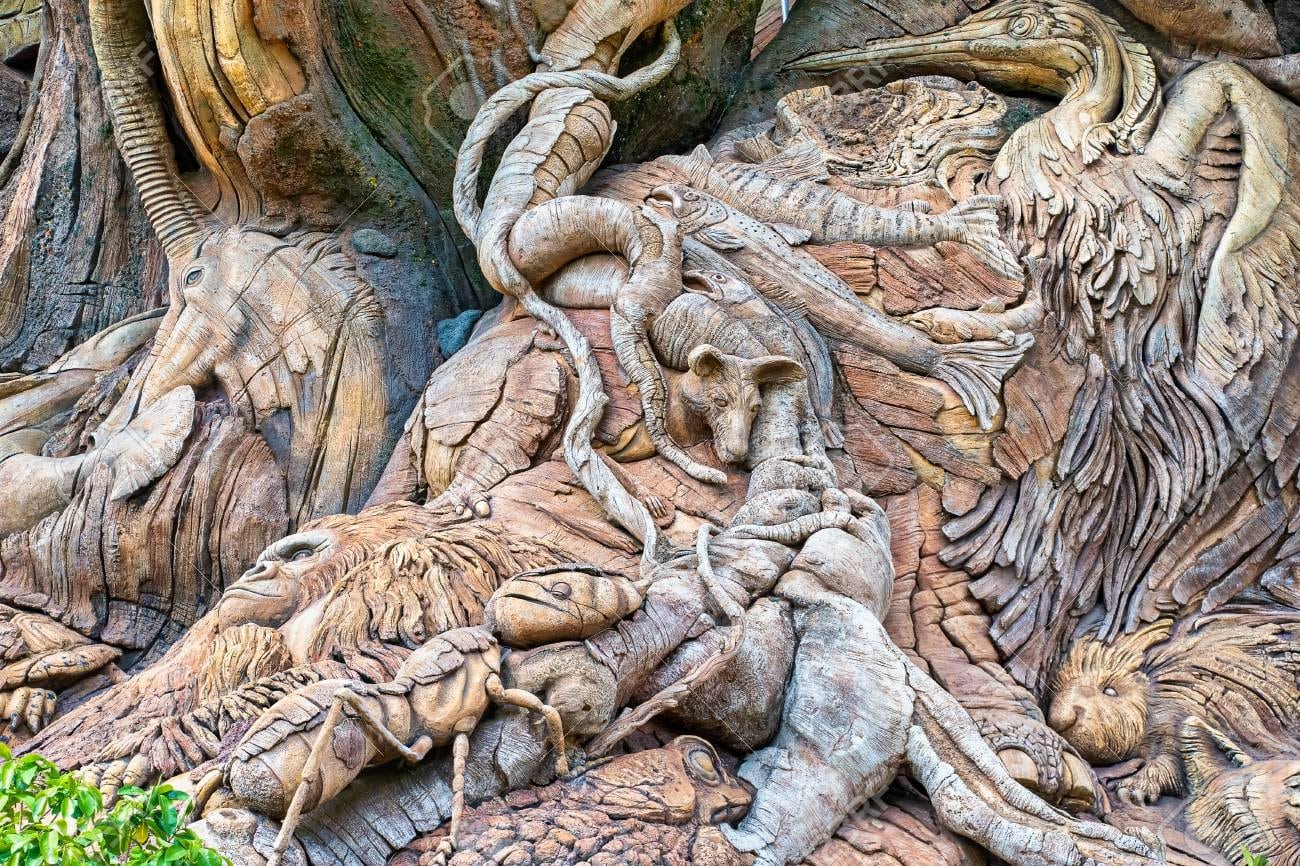Earth Day is upon us once more, and we are already in the heart of Earth Month. What better time to celebrate Disney’s most obvious symbol of environmental awareness? Come learn a few fun facts about the background, design, construction, and history of the Tree of Life, the majestic icon of Disney’s Animal Kingdom.
Disney’s Very Own Baobab Tree
An icon of the African continent, the baobab tree lies at the heart of many traditional African remedies and folklore stories. The prehistoric species predates mankind, and even predates the divergence of the continents over 200 million years ago. Baobab trees are succulents, meaning they can collect water during the rainy season, store it in the massive trunk, and ration it out during Africa’s long arid seasons. They even produce a nutrient-rich fruit in the process. This astonishing story of survival is how the baobab tree became known as the “Tree of Life” throughout African culture.
Speaking of life, the baobab can theoretically live for up to 5,000 years, with several notable trees having been dated at over 2,000 years. Baobab heights can reach up to 100 feet, and the massive water-storing trunks can be as wide as 10 feet in diameter.

Beyond Animal Kingdom’s Tree of Life, Disney fans have seen baobab trees in other places as well. Visitors to Disney’s Animal Kingdom can see several of them along the Kilimanjaro Safaris route. The trees are often described in myth as appearing to grow upside down, with the branches clung deep in the ground while the roots reach up to the sky.
Trivia tidbit: like the Tree of Life itself, the baobab trees in Kilimanjaro Safaris are artificial – formed of concrete. One single baobab tree did once exist in the park’s Harambe Village neighborhood, but it failed to survive a colder-than-normal Florida winter.
In Disney films, the baobab makes an appearance in 1994’s The Lion King, as Rafiki’s home in the tree. In the 2009 film Avatar, the “Tree of Souls” is modeled after the baobab.

Larger Than Life
The Tree of Life stands at a massive 145 feet tall – just missing the list of the top ten tallest structures in Walt Disney World, but securing its place as the tallest tree sculpture to exist. But perhaps more surprising is that the tree is actually wider than it is tall, with the tree’s canopy coming in at 165 feet in width.

As you might guess, a tree that large must sprout plenty of branches and leaves. The tree’s canopy structure sports over 8,000 individual pieces, including 12 primary branches, 45 secondary branches, 756 tertiary branches, and 7,891 end branches. Greenery is provided by over 100,000 foot-long thermoplastic kynar leaves, in five different shades – all made by hand. The tree’s branches and leaves were assembled on the ground, and then lifted by crane and fastened into place.
Disney’s Oil Rig – Hidden in Plain Sight
Early conceptual designs for the Tree of Life envisioned a modest 50-foot-tall tree in the center of a playground area for kids. But as Disney’s vision for the park grew, so did the size of the tree. Later concept art shows the tree large enough to support a viewing platform with an inclining walkway leading in. Eventually, Walt Disney’s tried-and-true concept of a “weenie” won out, and the idea for a larger-than-life baobab tree took shape.
A structure so massive needed solid support, especially considering Disney originally wanted to house a restaurant in the bottom level of the tree. That’s where the “engineering” part of “Imagineering” comes in. The base structure of the Tree of Life is actually an oil rig – like the kind used in off-shore drilling (of which the nation of Norway was so proud in the Dearly Departed EPCOT attraction Maelstrom).

Now there is a bit of conflicting information as to whether the Tree of Life is sculpted around an actual retired oil rig, or custom designed based on the existing designs of an oil rig. But suffice to say, the notion of an oil rig hidden inside the tree is quite a wild concept.
In the end, the inner dimensions inside the base of the tree hover around 50 feet – large enough for the attraction that has occupied the space since the park opened on Earth Day in 1998.
Iconic Tree Carvings
As impressive as the Tree of Life’s canopy and size are, the magic of Disney always lies in the details. In the case of the iconic tree, the details tally up to over 320 animal species carved around the trunk. To create this work of art, Disney assembled an international team of artists. The animals were carved out of a special plaster-like cement that was applied over the first layer of concrete, which was poured around the oil rig structure. The artists worked from the top of the tree downward, carving six to eight square foot sections within the 6 to 7 hours in which the concrete was soft enough to sculpt.

When exploring the Tree of Life, check out all sides of the tree, including the roots, trunk, and branches. The animals are found literally all over the tree. To progress Disney’s message of environmental responsibility, the animals sculpted into the tree celebrate existing species, and also honors those which have gone extinct.
Looking for one of Disney’s famous Hidden Mickeys? Here’s a tip – find the head of a hippopotamus, and you’ll be very close!
Trivia tidbit: During construction of the Tree of Life, esteemed primate researcher Jane Goodall visited the site and asked where on the tree she might spy a chimpanzee. As a result of Ms. Goodall’s inquiry, Disney artists sculpted one specific primate, modeled after Goodall’s most famous subject, David Graybeard. David is the only carving on the entire tree to have a name. You’ll find him at the base of the tree, near the entrance to the attraction It’s Tough to be a Bug!

It’s Tough to be a Bug!
Speaking of this attraction – It’s Tough to be a Bug has existed for as long as the park’s icon itself, which is appropriate, since bugs have been on Earth as long as terrestrial plants. After saying “hello” to David Graybeard and winding through the subterrestrial-feeling queue, visitors to the show find their seats in a 428-seat theater. The show is not exactly a headlining attraction, but between some pretty cool animatronics of Flik the Ant and Hopper the Grasshopper, and the creepy crawly (and frightening) nature of the seats themselves, this show offers quite a bit of entertainment!

Come see the bugs now, because they’re on the endangered species list! At the September 2023 Disney fan event Destination D23, it was announced that a new 3D-theater attraction based on the 2016 film Zootopia will be opening at the Tree of Life. Though not directly confirmed in the announcement, the new attraction is expected to replace It’s Tough to Be A Bug!
Trivia tidbit: Before deciding on a theater-style show inside the tree, Disney Imagineers considered having a restaurant at the bottom of the tree. One early plan titled the eatery “Roots Restaurant.” How fun would that have been???
I hope you enjoyed your journey inside (and outside) Disney’s Tree of Life. How does Animal Kingdom’s icon rank among those in the other Walt Disney World theme parks? Join the conversation with a comment on social: Instagram Facebook X
Sources:
The Imagineering Field Guide to Disney’s Animal Kingdom at Walt Disney World – Alex Wright, 2007
The Baobab Tree: Africa’s Iconic “Tree of Life” – Aduna Foods
Tree of Life at Disney’s Animal Kingdom – Jack Spence, All Ears, June 4, 2012




